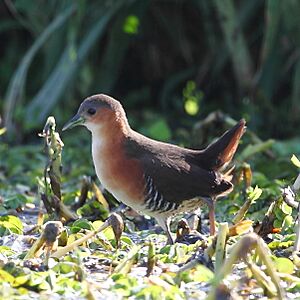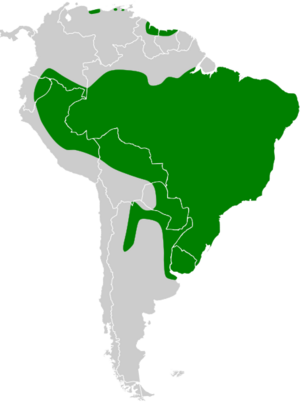Rufous-sided crake facts for kids
Quick facts for kids Rufous-sided crake |
|
|---|---|
 |
|
| Conservation status | |
| Scientific classification | |
| Genus: |
Laterallus
|
| Species: |
melanophaius
|
 |
|
The rufous-sided crake (Laterallus melanophaius) is a small, shy bird. It belongs to the Rallidae family, which includes rails, gallinules, and coots. You can find this bird in almost every country in mainland South America, except for Chile.
Contents
About the Rufous-sided Crake
The rufous-sided crake is a type of bird that has two main groups, called subspecies. These are L. m. melanophaius and L. m. oenops. Another bird, the white-throated crake, was once thought to be part of this family too.
What Does It Look Like?
This crake is about 14 to 18 centimeters (5.5 to 7 inches) long. It weighs around 50 to 60 grams (1.8 to 2.1 ounces). Both male and female crakes look very similar.
Their beaks are gray on top and light green on the bottom, with a white tip. Their legs and feet are light brown or olive green.
The most common type, L. m. melanophaius, has dark olive-brown feathers on its back. It has a gray color around its eyes. The sides of its face and chest are a reddish-brown color, called rufous or cinnamon rufous. Its throat and the middle of its chest are white. The sides of its body and its belly have blackish-brown and white stripes. The feathers under its tail are a dark reddish-brown.
The other type, L. m. oenops, looks much like the first. However, its back feathers are a bit lighter. It also has reddish-brown feathers on its forehead and around its eyes.
Where Do Rufous-sided Crakes Live?
The L. m. melanophaius subspecies lives in a very large area. You can find it along the coast of Venezuela and across the Guianas. It also lives in central and eastern Brazil. From there, its home stretches south through eastern Bolivia, Paraguay, and Uruguay, all the way to northern Argentina.
The L. m. oenops subspecies lives in a smaller area. It is found from southern Colombia, south through eastern Ecuador, into eastern Peru, and west into Brazil.
These birds mostly live in freshwater marshes. They also like places like flooded fields and the edges of ponds or lakes.
How Do Rufous-sided Crakes Behave?
Movement and Travel
The rufous-sided crake does not travel long distances. It stays in the same area all year round.
What Do Rufous-sided Crakes Eat?
This crake usually looks for food in thick grassy areas. Sometimes, it will search in open spots, but always close to places where it can hide. It finds its food in mud and plants. Its main diet is small insects and other tiny creatures. It also eats seeds and leaves.
Reproduction and Life Cycle
We don't know much about how rufous-sided crakes raise their young. In Argentina, they are known to nest in September and October.
Their nest is shaped like a ball and made of leaves. Inside, it's lined with shredded leaves, dry grass, and feathers. The nest is built on or very close to the ground. It has an entrance on the side. The eggs hatch after about 20 days.
What Sounds Do They Make?
The song of the rufous-sided crake sounds like a "rubbery musical trill." This is similar to the songs of other crakes in its family. Its calls include high-pitched "tinkling" sounds. It also makes a short treeeeeng and a harsh, descending djreer sound.
Is the Rufous-sided Crake in Danger?
The IUCN (International Union for Conservation of Nature) says the rufous-sided crake is a species of "Least Concern." This means it is not currently in danger of disappearing. It lives in a very large area, but we don't know exactly how many there are or if their numbers are changing. No immediate threats have been found.
It is thought to be uncommon in some places like Ecuador, but fairly common in Peru. Human activities don't seem to have a big effect on these crakes right now. The only real problem is when their homes are destroyed.


